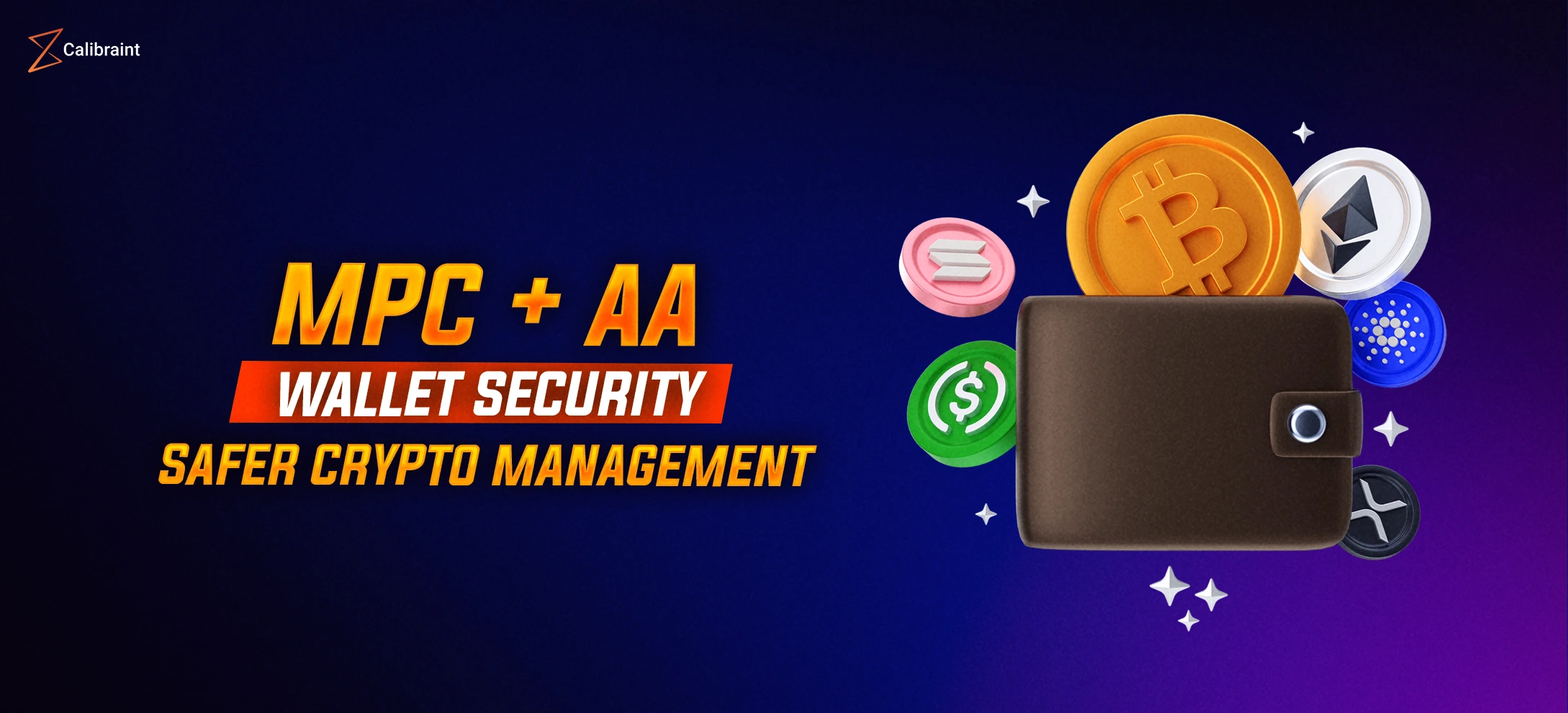Best Blockchain Interoperability Tools to Connect Multiple Networks
Calibraint
Author
September 28, 2025
Last updated: November 14, 2025

Imagine an enterprise managing multiple blockchain networks for payments, asset tracking, and digital identity. Each network operates independently, creating silos that slow operations, increase costs, and hinder strategic opportunities. Now, picture these networks seamlessly connected value and data flowing securely, decisions made faster, and cross-chain innovation unlocked. This is the promise of blockchain interoperability tools.
The blockchain interoperability market is projected to grow from $0.7 billion in 2024 to $2.55 billion by 2029, reflecting a Compound Annual Growth Rate (CAGR) of 29.3%. CoinLaw This rapid growth underscores the increasing demand for solutions that enable seamless communication between disparate blockchain networks.
The Challenge of Siloed Blockchain Networks
Enterprises increasingly rely on blockchain for digital transformation, from supply chain optimization to decentralized finance (DeFi) initiatives. Yet, as organizations adopt multiple networks, a pressing challenge emerges: isolated blockchains. Each ledger maintains its own rules, tokens, and smart contracts.
Operating in these silos creates critical issues:
- Inefficient asset movement: Transferring tokens or data across blockchains is slow and often requires intermediaries.
- Increased operational costs: Maintaining multiple independent networks duplicates effort in security, compliance, and monitoring.
- Limited innovation potential: Projects like DeFi protocols, NFTs, or cross-border payments require multi-chain interoperability to reach scale.
Enterprises seeking a competitive edge must embrace multi chain connectivity solutions that unify these fragmented ecosystems while ensuring security, compliance, and efficiency.
To understand how enterprises are leveraging blockchain to overcome these silos and unlock new opportunities, check out this guide on the Best Blockchain Interoperability Tools to Connect Multiple Networks.
What Are Blockchain Interoperability Tools?
At their core, blockchain interoperability tools are designed to enable secure, seamless communication between distinct blockchain networks. They function as the connective tissue that allows data, assets, and smart contracts to move freely while maintaining the integrity of each network.
Think of isolated blockchains as islands. Traditional methods required ships to ferry goods between them, incurring risk and delays. Blockchain interoperability tools build bridges and tunnels enabling instant, trustless transfers and coordination.
Key strategic benefits include:
1. Cross Chain Protocol Security
Security is paramount in multi-chain operations. Modern interoperability solutions incorporate robust cross chain protocol security measures, such as threshold signatures, on-chain verification, and decentralized oracle systems. These protocols minimize fraud risk while allowing organizations to execute transactions across networks without relying on central intermediaries.
For enterprises, this translates into reduced operational risk, compliance adherence, and the confidence to scale digital initiatives across diverse blockchain platforms.
2. Operational Efficiency and Cost Savings
By connecting disparate blockchains, interoperability tools eliminate redundant processes, streamline transactions, and reduce settlement times. Enterprises can consolidate operations that once required separate teams, tools, and audits, resulting in tangible cost savings and faster time-to-market for innovative products.
For example, supply chain firms can track assets across multiple blockchains, automating reconciliation and reducing human error. Financial institutions can settle cross-border payments in near real-time without costly intermediaries.
3. Future-Proofing Digital Assets
The pace of blockchain innovation means networks evolve quickly. Interoperable blockchain solutions safeguard investments in digital assets by ensuring compatibility with emerging protocols and standards. Enterprises leveraging these tools can adopt new networks, DeFi applications, or token standards without disrupting existing systems future-proofing both operations and strategic growth.
Key Applications of Blockchain Interoperability Tools
Cross Chain Bridge Protocols
Cross chain bridge protocols are at the heart of multi-chain connectivity. These protocols enable token transfers and data exchanges between incompatible blockchains.
Enterprise use case: A multinational logistics company uses a cross-chain bridge to track inventory and payments across Ethereum, Solana, and Hyperledger networks. The result: real-time visibility, reduced reconciliation costs, and enhanced trust across partner ecosystems.
By choosing bridges with proven cross chain protocol security, organizations mitigate risk while enabling seamless operations across multiple platforms.
Blockchain Network Integration for Large-Scale Operations
Blockchain network integration allows enterprises to consolidate multiple ledgers into a unified operational framework. Integration involves aligning protocols, standardizing smart contracts, and leveraging APIs or middleware for cross-network communication.
Strategic impact: Large financial institutions adopting interoperable solutions can integrate multiple payment rails, DeFi lending platforms, and tokenized assets into a single dashboard. This not only enhances operational insight but also accelerates decision-making.
Interoperable Blockchain Solutions for DeFi, NFTs, and Enterprise Adoption
Interoperable blockchain solutions extend beyond traditional finance applications. They are enabling next-generation ecosystems such as:
- DeFi networks: Unlocking cross-chain liquidity, lending, and staking opportunities.
- NFT marketplaces: Facilitating asset movement and fractional ownership across networks.
- Enterprise blockchain adoption: Supporting supply chains, IoT integrations, and digital identity frameworks.
For developers, interoperability tools for developers offer prebuilt SDKs, smart contract templates, and developer-friendly APIs. This accelerates deployment, reduces technical friction, and allows organizations to focus on innovation rather than infrastructure challenges.
Real-World Examples: Leading Platforms Driving Multi-Chain Connectivity
Several platforms are emerging as benchmarks for enterprise blockchain interoperability. These tools showcase measurable strategic benefits, from cross-chain liquidity to enterprise adoption:
1. Polkadot
Polkadot enables heterogeneous blockchain networks to communicate via its relay chain and parachains. Enterprises leveraging Polkadot benefit from secure, scalable connections and reduced integration overhead. For example, DeFi platforms have tapped Polkadot for cross-chain lending protocols that increase liquidity without sacrificing security.
2. Cosmos
Cosmos employs the Inter-Blockchain Communication (IBC) protocol to facilitate decentralized interoperability. Large-scale enterprises have used Cosmos to integrate multiple private and public blockchains, improving data consistency and operational efficiency.
3. LayerZero
LayerZero provides ultra-lightweight cross-chain messaging, enabling instant and low-cost asset transfers. Its adoption has allowed gaming and NFT platforms to expand their ecosystems while maintaining user trust and security standards.
4. Chainlink CCIP
Chainlink’s Cross-Chain Interoperability Protocol (CCIP) empowers enterprises to send data, commands, and tokens across chains reliably. Financial institutions and supply chain operators are increasingly adopting CCIP to unify operations without exposing themselves to cross-chain vulnerabilities.
Strategic Takeaways for Decision-Makers
Implementing blockchain interoperability tools is not merely a technical upgrade; it’s a strategic initiative that drives measurable business outcomes:
- Enhanced ROI: Faster settlement, reduced intermediaries, and unified operations deliver cost savings and revenue potential.
- Risk Mitigation: Cross chain protocol security ensures that assets, data, and smart contracts are protected.
- Innovation Enablement: Enterprises can adopt emerging networks, token standards, and DeFi applications without operational disruption.
- Competitive Advantage: Multi-chain interoperability positions organizations ahead of competitors constrained by siloed operations.
The Road Ahead: Best Interoperability Tools 2025
Looking forward, interoperability tools are poised to become a standard enterprise requirement. Analysts predict that by 2025, organizations will increasingly prioritize solutions offering:
- Universal protocol compatibility
- Advanced security features for cross-chain transactions
- Developer-friendly APIs and SDKs for rapid deployment
- Scalable architectures to accommodate evolving blockchain ecosystems
By investing strategically in blockchain interoperability tools, organizations are not just connecting networks, they are laying the foundation for resilient, agile, and innovation-ready digital operations.
Conclusion: Partnering with Expertise
Navigating the complexities of multi-chain ecosystems requires more than just tools, it demands a partner who understands how to align interoperability with enterprise strategy. At Calibraint, we design and implement secure, scalable blockchain interoperability solutions tailored to your business objectives. From cross chain bridge protocols to full-scale blockchain network integration, our team ensures your organization is future-proofed for the rapidly evolving digital economy.
Explore Calibraint’s Blockchain Development Company Services and start building a connected, innovation-ready blockchain infrastructure today.
Calibraint
Author
September 28, 2025
Last updated: November 14, 2025



























